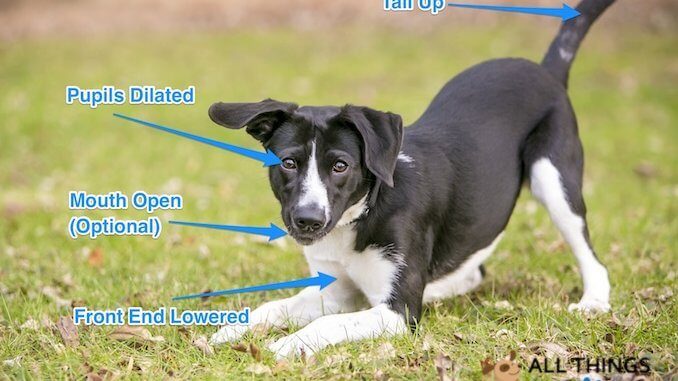
When it comes to understanding dog body language, despite the fact our dogs cannot talk, it doesn’t have to be difficult.
However, there probably isn’t one day that passes where owners wish dogs could talk!
There would be so many questions we would ask our dog: How they are feeling? Whether they do in fact like retrieving that tennis ball for the 600th time or are they just doing it to please us?
Back to body language then, even without speaking, dogs do communicate, some more subtly than others.
A dog’s body language tells us exactly how they are feeling, we just have to know what we are looking for.
So to help you understand dog body language, we have put together seven real life examples to help you figure out what is going on in your four legged friend’s mind.
For those more adventurous, we also have a quick dog body language chart with a quiz to test your knowledge at the end!
TABLE OF CONTENTS
- 1. Play Bow - I Want to Play!
- 2. Dog Belly Rub - I'm Happy
- 3. Dominant or Aggressive - I'm Not Approachable
- 4. Fearful Submission - Leave Me Alone
- 5. Ears Perked - I'm Interested
- 6. Relaxed & Approachable - I'm Calm
- 7. Fearful & Worried - I'm Not Approachable
- Dog Body Language Chart
- Dog Body Language Quiz
- Summary
1. Play Bow – I Want to Play!
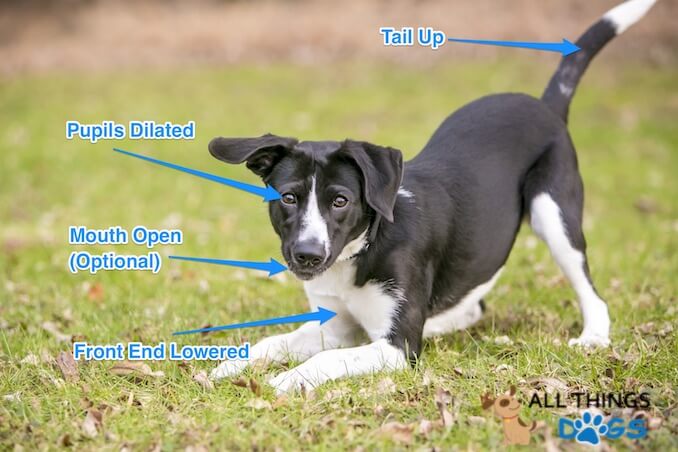
From Adobe Stock
One of the most common signs of dog body language! The famous play bow. You’ve all seen it!
Anyone who has raised a puppy will notice this immediately. Puppies will lower their front end and stick their bottom in the air. Their tail will be up, often wagging.
Sociable puppies will do this to anything, a dog they meet and even the vacuum cleaner.
They learn very quickly who reciprocates. The vacuum rarely does!
They carry this behavior throughout their life – it is the universal “let’s play!” or “ready to chase?”. Some dogs will bark when they bow, this is usually a more high pitched bark, quick and snappy.
2. Dog Belly Rub – I’m Happy
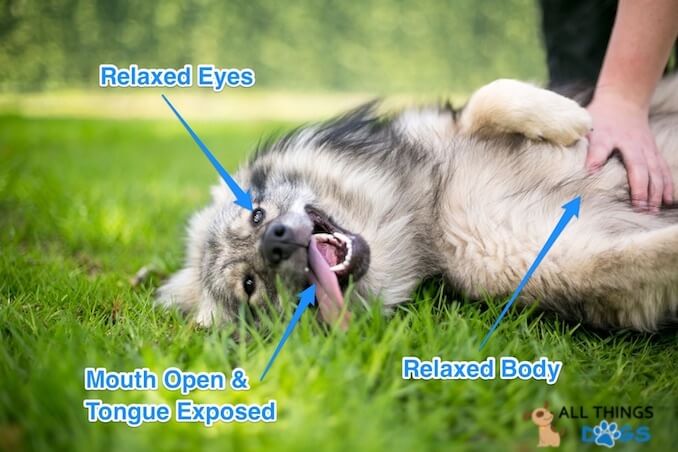
From Adobe Stock
Some owners think when their dog rolls on the floor, they are being submissive, but understanding dog body language in this scenario requires a little bit more understanding.
Dominance theory training has been widely debunked.
When a dog rolls over, tongue lolling in their mouth, exposing their belly – you can bet your life, they actually just like having a belly rub.
Their body will be relaxed, their mouth will be open, tongue likely hanging out.
They will have relaxed eyes – they could be open or closed.
Some dogs will sleep like this; you’ll see some incredible yoga poses from sleeping dogs! They trust that they are safe and are actually, just comfy.
3. Dominant or Aggressive – I’m Not Approachable
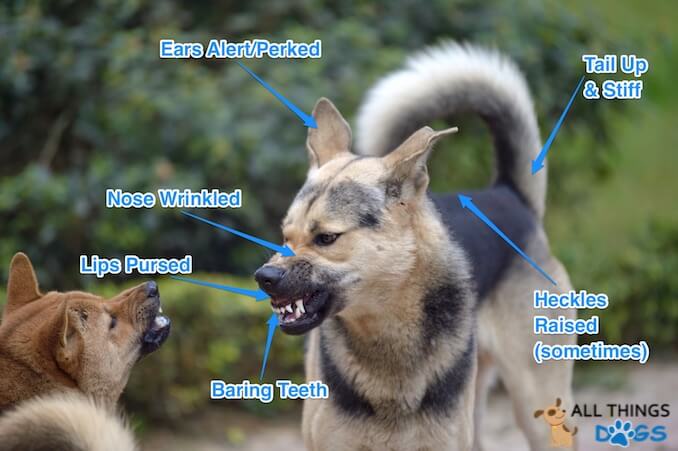
From Adobe Stock
In this instance, he is not a happy dog.
An aggressive dog will have his tail up. Their ears are perked and alert. He will likely be snarling and baring his teeth and his nose will be wrinkled. You will likely notice hackles on his back (by this we mean raised hair along his shoulders and down his spine).
Some believe dogs do this to make themselves look bigger and therefore more threatening.
But if we consider the stress response in humans, when we are facing a stressful situation, our brain turns on a plethora of actions in our body. This includes constricting the blood vessels in our skin.
In an evolutionary sense, this was to reduce blood loss should an altercation occur. The constricted blood vessels cause our hair to stand on end. We wonder if this is what is happening in dogs too and in fact that’s why their “hackles are up!”.
4. Fearful Submission – Leave Me Alone
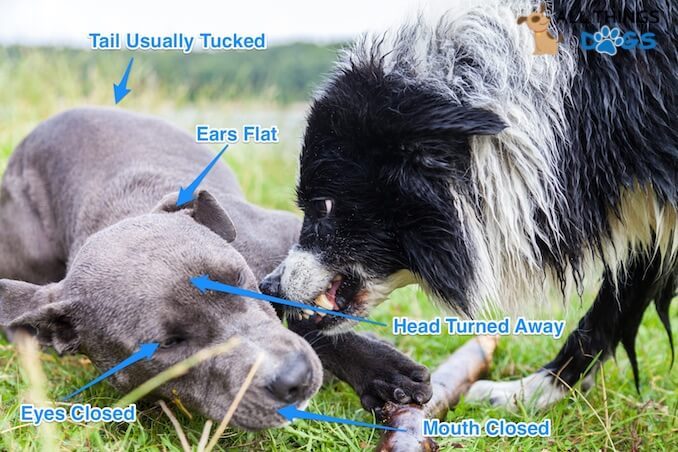
From Adobe Stock
Interpreting dog body language in this picture is easy!
This dog just wants to be left alone.
A fearful dog may roll completely onto their back exposing their stomach and throat. They will usually turn their head away to avoid confrontation. Their ears will be flat and back.
If they have a long tail, it will often be tucked between their legs.
Many fearful dogs will close their eyes, again to avoid confrontation.
They are hoping if they don’t get involved, or don’t respond, the aggressor will just leave them alone.
5. Ears Perked – I’m Interested
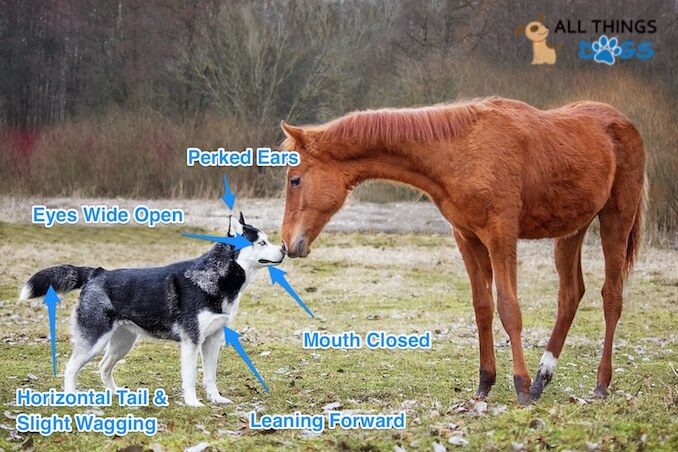
From Adobe Stock
The dog body language here indicates your dog is interested. This dog is very confident and very interested in his new friend or object.
His tail will usually be horizontal and may wag slightly. You will notice that he is leaning in slightly to his new friend.
His eyes are wide, to take all the information in. His ears are perked and alert. Despite being interested, his posture is relaxed and non threatening.
6. Relaxed & Approachable – I’m Calm
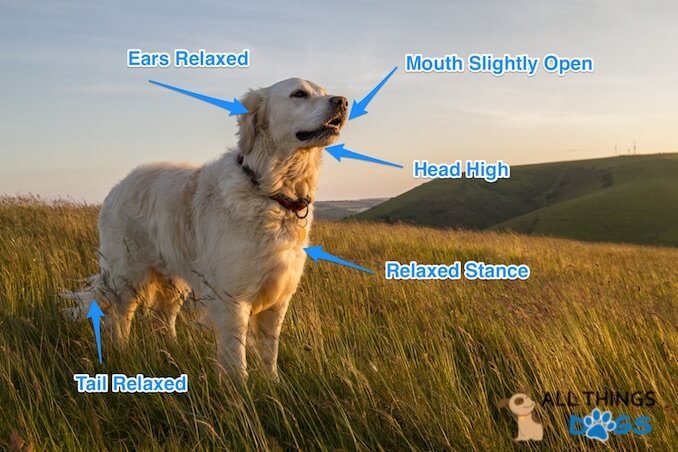
From Adobe Stock
The relaxed and approachable dog will have a totally calm demeanour.
Their head will be high, showing interest and they will move freely.
Their tail may be up or down, depending on breed but it will sit naturally, not stiff.
Their ears may be up or down, also depending on breed.
A relaxed dog will usually have their mouth partly open, they may be panting, but not excessively.
7. Fearful & Worried – I’m Not Approachable
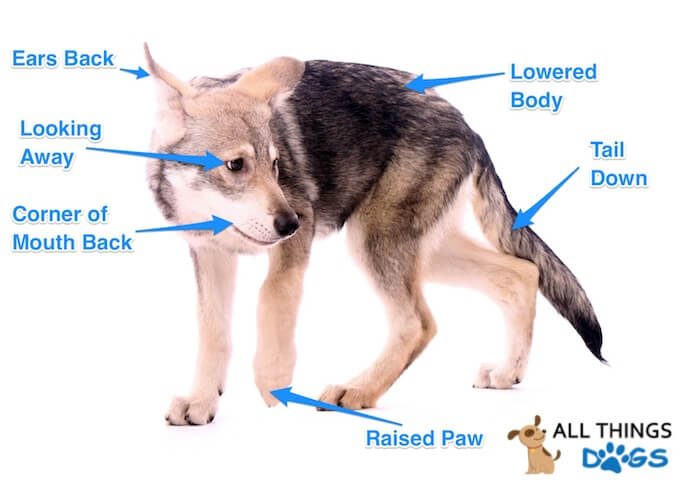
From Adobe Stock
This is another scared dog, but still contemplating they may be able to escape the situation, slowly.
Here you will notice they will be looking away, they may even close their eyes slightly.
Their body will be lowered and they may be moving or walking very tentatively; some dogs will even raise a paw.
Their ears will be flat and back; their mouth often closed.
Their tail will be down, sometimes even tucked. Some dogs may attempt to very slowly wag their tail.
Dog Body Language Chart
In order to help you learn how to read dog body language, we have created an easy to follow dog body language chart:
| Body Part: | Meaning: |
| Eyes | A relaxed dog will have almond shaped eyes. They sometimes appear to squint at you. A stressed or fearful dog will usually have dilated pupils and the whites around their eyes will be on show. Fearful or worried dogs will tend to look away and avoid eye contact. Aggressive dogs will sometimes stare; if two dogs lock gaze intently, it rarely ends well. |
| Mouth | A happy, laid back dog will have a relaxed mouth. It will usually be open and they may pant. He may appear to smile. Stressed or fearful dogs will usually purse their lips and keep their mouths closed. On the other side of the scale, a dog who is excessively panting when it’s not particularly hot or they haven’t been exercised is usually stressed. Drooling when there is no food present is also a sign of stress in dogs. In an aggressive dog, the mouth is usually the clear give away. They may curl their lip and wrinkle their muzzle. They may bare their teeth and snarl. You may hear a deep growl through clenched teeth! |
| Ears | In a relaxed dog, their ears will be in their natural state, whether this is up or down. It’s easier to read the ears of those dogs who typically have pointy ears. When they are stressed, they will lay flat and back. With floppy eared dogs it is still possible to read their ears, you just have to look at the base of their ear; you may notice movement. Movement forward shows interest, movement back shows stress or fear. |
| Tail | A stressed or fearful dog will tuck their tail in between their legs. They may wag it slightly, but very slowly. An aroused, interested or aggressive dog will raise their tail. This is where the rest of their body language comes in, to help you distinguish how they are feeling. |
| Hair | We mentioned their hair earlier on – you may notice hackles on an aggressive or fearful dog, you may notice that their tail fans out too. Stressed dogs also shed hair. Many owners notice handfuls of hair coming out of their dog during their vet visit. |
| Posture | Watch your dog’s general posture – if it is stiff and upright, you can bet your life they’re not happy about something. If they are cowering away, making themselves smaller and walking tentatively they are pretty worried. |
Dog Body Language Quiz
Think you’ve got to grips with your dog’s body language? Let’s see.
What do you think is going on in these photos below?
If you’re not confident yet, re-read the dog body language chart above and try looking at the seven examples above.
Q1 – What’s Happening Below?
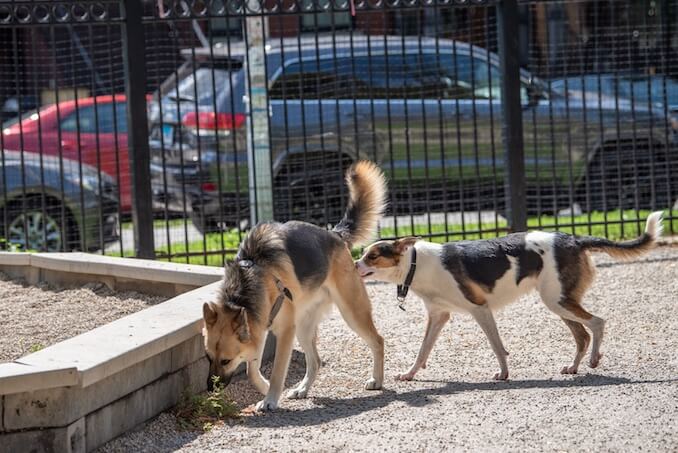
From Adobe Stock
Q1 Answer – Interested
This would be the ideal scenario in the dog park.
The dog on the right is interested, he has a horizontal tail and a relaxed posture despite leaning forward.
The dog on the left is quite happy being sniffed, he has relaxed posture; yet his tail is up, this could be to allow the other dog to sniff, or he himself could be sniffing something which interests him.
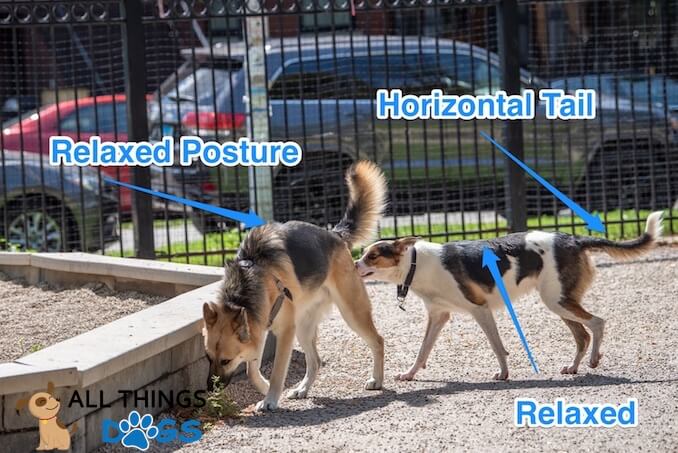
From Adobe Stock
Q2 – What’s Happening Below?
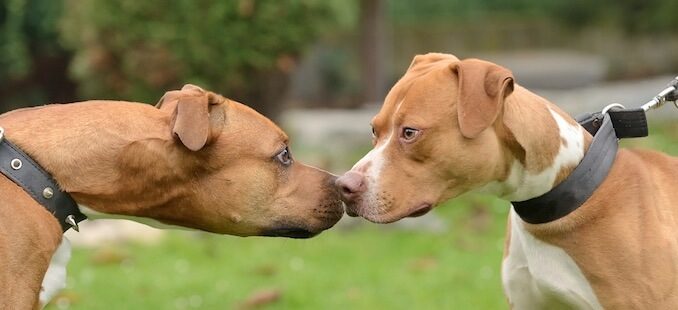
From Adobe Stock
Q2 Answer – This won’t end well
You should immediately notice the fixed gaze between these two dogs.
They are both pulling on their leashes.
You will see the whites of their eyes are on show.
Those eagle eyed readers will notice the ears on the dog on the left; the base of the ears are moving back, suggesting fear. This scenario is unlikely to end well.
Owners should calmly distract and move these dogs away from each other.
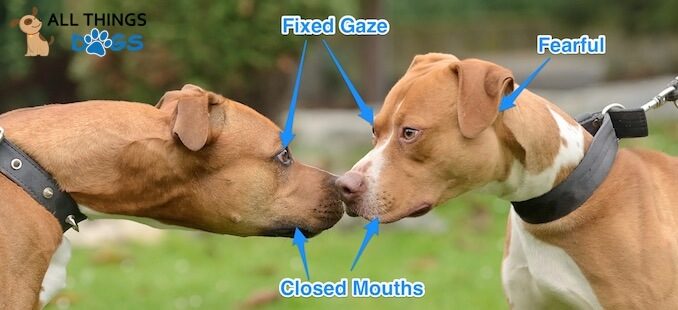
From Adobe Stock
Q3 – What’s Happening Below?
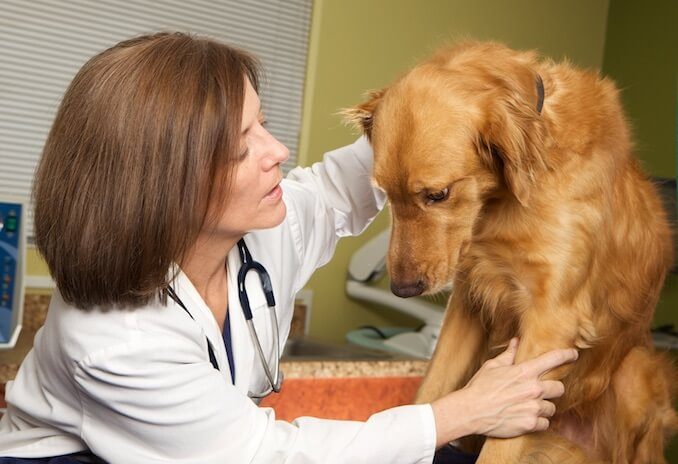
From Adobe Stock
Q3 Answer – Fearful or Submissive
This may be a typical visit to the vets for some of you.
This dog really doesn’t want to be there; his head is lowered and he is looking away.
The whites of his eyes are on show and his mouth is pressed closed.
He just wants to be left alone.
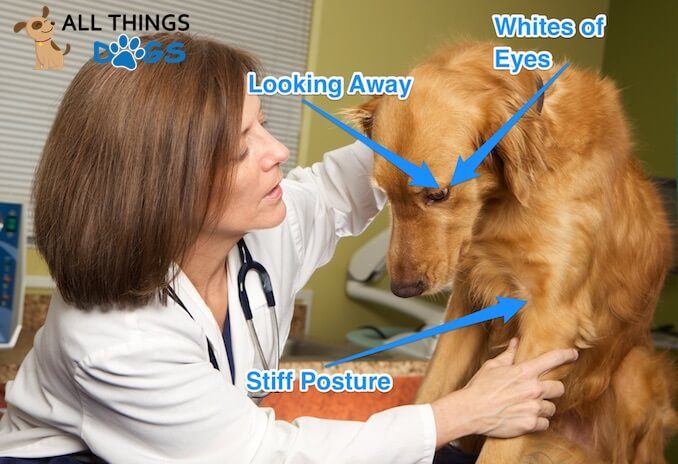
From Adobe Stock
Q4 – What’s Happening Below?
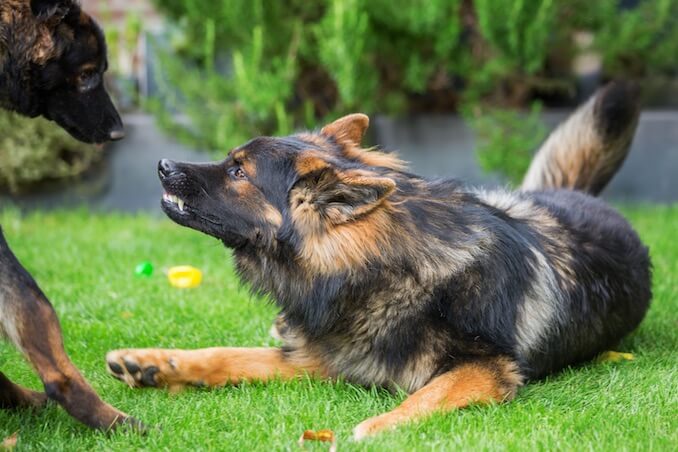
From Adobe Stock
Q4 Answer – Scared or Worried
At first glance you may see an aggressive dog.
She is actually fearfully aggressive and asking to be left alone. She is remaining on the floor as she doesn’t really want confrontation.
Her bared teeth are a warning that she just wants to be left alone.
Her raised tail signals arousal and if the warning isn’t heeded, she may further protect herself.
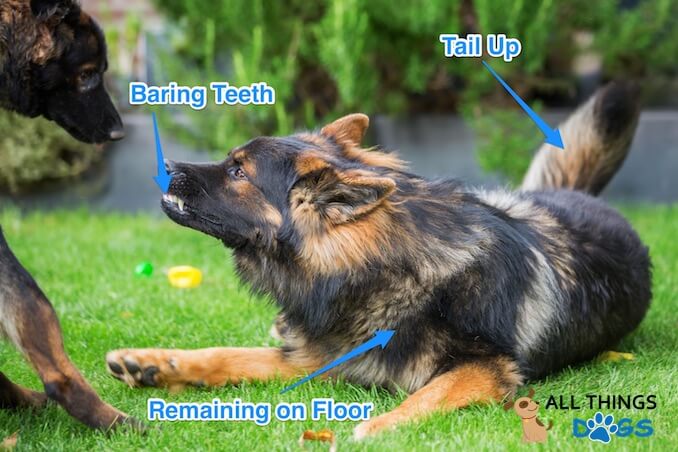
From Adobe Stock
Summary
Owners who spend time understanding their dog’s body language put themselves in a much better position when socializing their dog and subsequently avoids potential disasters.
Understanding dog body language isn’t hard.
If you notice the early signs that your dog is unhappy you can remove them from the situation, before it gets too much for them.
We know that dogs learn best through positive reinforcement and reward based training. Flooding a dog with experiences so they get used to it rarely has a positive outcome.
Noticing their little nuances and understanding their behavior enables us to raise a stable and well-rounded dog.
In equips us to avoid those less than friendly dogs in the park and ultimately lets our dog know that even though they can’t talk, we are trying our best to understand them.
Has your dog been communicating with you lately? Is there any body language which your dog displays which isn’t listed above? Let us know below.

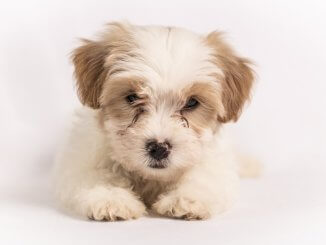
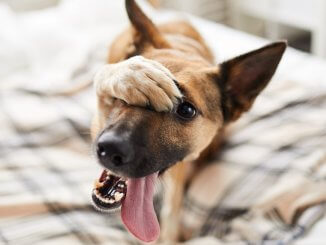
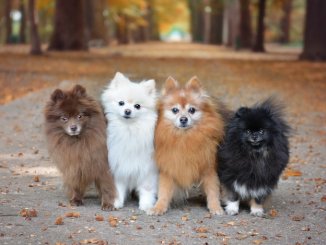
Why does my dog licks his front paws a lot?
Hi James,
This could be due to an allergy, anxiety, boredom or grooming. Feel free to read our article on 8 reasons dogs lick their paws.
When my dog licks me, is he showing love?
Hi Nancy, there are many reasons for why your dog might choose to lick you – it could be love. It might also be stress. You can read our full article on why dogs lick here.
Hi, how can I help my dog who normally at home walks around in picture 7 fearful or worried? Are there training exercises we can do to build confidence?
Hi Jim,
Your dog sounds quite stressed. Firstly, it is important to understand what is causing their fearful or worried response. Do you notice their behaviour at any particularly times of the day or around certain people? Is it when the house is busy? Do you have other pets? Or children?
Be mindful of what is going on in the home when they are behaving this way and keep a diary. You may be able to figure out the triggers yourself or you may need the support of a qualified trainer or behaviourist. With any fearful or worried dog it’s essential to reduce their stress-load and you can’t do this until you know what’s causing it.
A little more information or history would be helpful, or if it’s something you are concerned could worsen, please seek professional advice, whether this is your veterinarian or a qualified behaviourist.
Hi John,
I have a 15 month old viszla cross boxer. Recently she has had 2 incidents of fights, where she has bitten the other dogs. She’s was well socialized as a puppy and still is but does display sometimes aggressive behaviour towards other dogs, Especially if they growl at her first. She loves to play with dogs,and does the play bow a lot, but also does this lying down on her belly then charging at the other dog…. Sometimes right past them. She is a fantastic family pet and we love her but this unpredictable behaviour is very stressful. Do u have any ideas why she does this?
Regards
Suzanne
Hi Suzanne,
It would be interesting to understand more about these 2 two incidents? The other dogs’ growling suggests that they’re not happy with something in the situation? Did she have any altercations with any dogs when she was younger?
For the time being, I would keep her on a leash around other dogs. A long line would be perfect for more open spaces. She will have the freedom to roam but you won’t be running the risk of any incidents with other dogs. Whilst we all want our dogs to have friends, we can’t always be sure how well socialized other dogs are. Dog etiquette is hard to learn!
Equally, aggression is a response to stress. Whilst she is running and charging around, she will already be in a heightened state of arousal, she may therefore be even quicker to respond to a stressor. Watch her body language when you are out and about, you may start to notice when she becomes stressed (lip licking, yawning, stiff posture etc). It is important to avoid those stressors in future or at least work on desensitizing and counter-conditioning. For example, if she starts pulling or lunging towards a dog in the distance, retreat to a space where she doesn’t respond. Slowly move further towards them, providing she is remaining calm, with praise and a handful of treats.
If she is in a state of high-arousal, it could be worth spending time at home working on impulse control games. When she’s calm, teach the leave it command or stop command. For leave it, hold a treat in your hand. She will instinctively sniff at it. As soon as she turns away, give her the treat and label the behaviour. She learns that when she leaves it, she gets it anyway! For stop, ask her to come to you, then throw treats behind her. She’ll stop to eat them.
Aggression in dogs can be concerning, so please seek the advice of a qualified trainer or behaviourist in your area if there are more incidents.
Hi John!
My male border collie loves to “hold hands”. When I’m petting him, he’ll often sit on his butt and put his paw on my wrist, or hug both my wrists with his both paws. Does this have a meaning for him? It’s very endearing but I’m not sure if I’m encouraging a behavior that should not be encouraged!
Thanks for all your articles, very informative! 🙂
Kai
Hi Kai,
You say he does it when you are petting him? Once he does it, does it make it difficult for you to continue petting him? So, you stop?
Dog’s generally behave a certain way to achieve an end result. Like they will nuzzle your hand on the desk, so you pet them, or they roll over just as you walk past so you rub their belly.
Cats will often swipe at you to stop you petting them when they’ve had enough – I wonder if your dog is asking you to stop petting him?
If you usually continue petting him, and he continues to hold hands, perhaps it is just an endearing quality? If this is the case, is it creating an issue for you? If it’s not, I personally wouldn’t worry about it. If you aren’t comfortable with it, simply stop interacting with him when he does it. He’ll soon stop.
Hope this helps!
Hi John,
I have a 1 year old corgi. It is very easy to get his attention and “control” him. But when there’s visitors in the house, he gets all excited and explodes with so much energy. It is impossible to command him to sit or stay anymore.
Same thing happens when I bring him out on walks, he gets so excited, everything catches his attention, it is impossible to give him commands. Even with the leash on, he charges wherever he wants to go, almost pulling me along. When I do a slight tug back he slows down then almost immediately picks up speed again till the leash is tension. I tried using the short leash method but no results too.
His problem is he either charges and burns out fast and then he walks super slow, slower than me until I almost have to drag him if not he will just stop every few steps. When I’m outdoors, I may get his attention max for like 1 sec, he will look at me and then immediately look away excitedly at some other thing.
Its not aggression, it is totally harmless in that sense. But he is too hyper and uncontrollable outside or indoor when there are visitors.
Any advice?
Noel
Hi Noel,
Thanks for your question – sounds like an unruly adolescent. Life is exciting, but hyper-arousal also increases cortisol levels in your dog which can lead to stressed behaviour.
It would be beneficial for you to work through some tasks to help him develop some self-control or impulse control, as it is commonly termed in the dog world.
Firstly, you need to teach the sit or down command that is pretty reliable.
Next, get your dog excited by playing a game. In the middle of the game, stop all interaction, stand like a tree and quietly ask for a sit or down. Wait until this happens. As soon as he does, re-start the play. The reward for calming down, is playing again. Your dog will soon learn that good things follow being calm. You can progress by using wait times, so ask your dog to sit for 10 seconds, 20 seconds, 30 seconds etc. Keep sessions short so you are not arousing your dog to the point of no return.
Regarding visitors, you can use baby gates or use your dog’s crate training (if this applies). Ask someone to help you initially so you can train. Place your dog in his crate or behind the baby gate. Ask your helper to come to the door. Your dog will likely become excited. Let them through the gate or out of the crate when they are calm. If this doesn’t happen, allow your guest to enter your home and carry on with your normal business. Again, let your dog out when he is calm. Avoid using commands, just ignore him until he is calm. He will learn that the reward is seeing the visitor, when he is calm.
You could also introduce interval walking. So, on a 10-minute walk, you need to ask your dog to sit 5 times, reward with high value treats. Then on a 20-minute walk, you may ask him 3 times. Lure him if necessary, to start off with. The point is to get his attention for a reason.
Finally, consider introducing brain games at home – these are a great way to keep his mind stimulated in a calm way.
I have a small rescue male dog that is 3 years old, we got him at 5 months. He is very aggressive with strangers and has actually nipped at a few family friends who came to our house. Once he knows and trusts you he loves you. This aggression also happens when we walk him. Can you advise what to do?
Hi Louise,
Sounds like you’re having a tough time with your pup! Was he aggressive when you rescued him or is this a new development? With reactivity it’s important to only work on one thing at a time. So let’s look at the behavior towards people in your home. You need to keep his stress levels low. Is he crate trained? If not, this is a good place to start as you can use it as a safe space or quiet den for him. No-one is allowed in, it’s just his.
When you are expecting visitors, ask him to go to his safe space. Over time, you may put him behind a baby gate or partition, so he can see the people in the home and see they pose no threat. In this case, you can ask your visitors to throw threats to him. Don’t engage, just throw treats intermittently.
Be patient, this could take a long time, and he may be separate to guests in the home for a while. Separate to the reactivity training, you could work on teaching the “bed” command. If he is remaining calm in your training so far, you could progress to having a bed in the room you usually have guests and ask him to go to bed when they arrive.
It’s helping him figure out what behaviour he needs to carry out at that moment. If you are concerned about his behavior, please seek the advice of a qualified behaviourist in your area and keep him separate to visitors until you have a plan in place.
I have a 1yr old boxer mix who is 80lb of muscle. I am having 2 problems with him. I have been very consistent with leash training but he still pulls too much. Second, he isn’t a barker but whines when doesn’t get his way. Any additional tips?
Hi Sandy,
He is arguably an adolescent. So, he will still be pushing the boundaries, literally. Maintain your consistency with leash training. What are you defining as fully leash trained? On your second issue, when you say he doesn’t get his way, can you give us some examples?
We rescued what we think is a Mountain Cur, about 1 year old she is very smart, but leery about strangers, we have started telling our company to ignore her. That has worked pretty good she will eventfully come up to them, check them out. Maybe after 30 minutes she is best friends. I have been reading about her maybe breed, there are so many good qualities, and a few to be worked on. She is our 6th rescue, we have always had Lab mix.
My dog is 13yrs old. We would like known why he shows aggressiveness to either one of us when he eats. He shows his teeth and growls.
Hello! You have great body language pictures! I am the volunteer manager for a humane society and am putting together basic training for our dog volunteers. Is it possible for me to copy some of your photos (leaving your logo on them) and put them in a PowerPoint presentation?
Thanks for the information!
Excellent detailed information on how to read your dog’s body language! You’ve really done a superb job! The photos are extremely helpful. My rescue dog, Henry has a bobbed tail. I’m not sure why since he’s a cockapoo or so we think. At times I feel like I don’t pick up on all his cues because he has a bobbed tail. This is helpful, even for a bobbed tail dog.
I’m sharing with my dog friends. 😊💖🐶